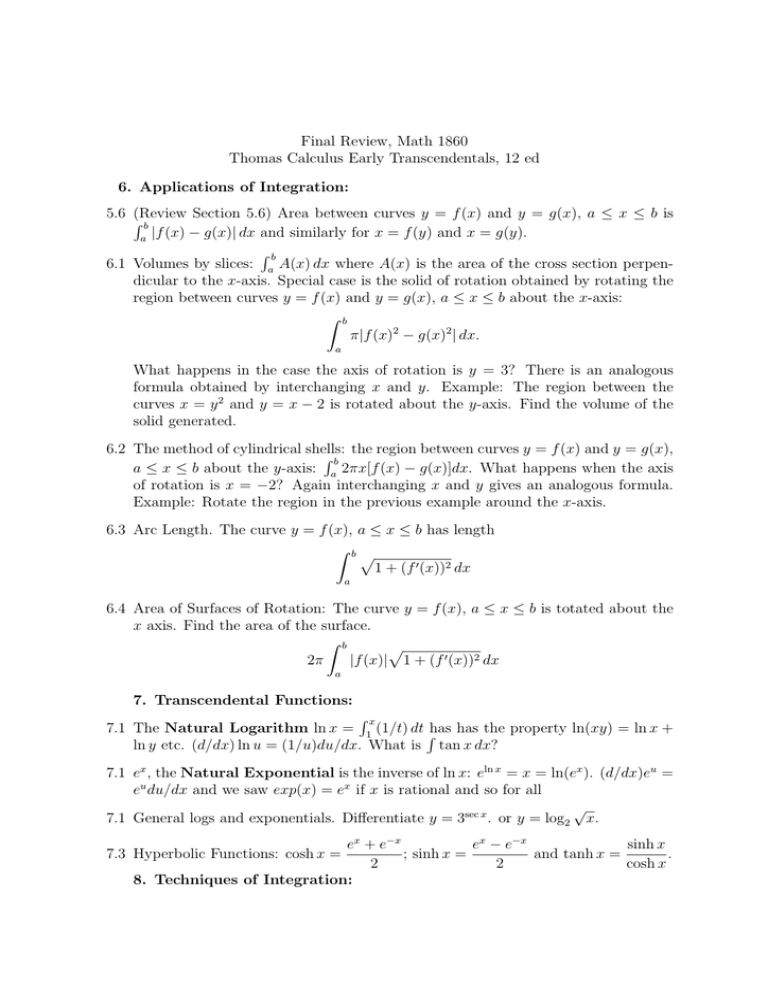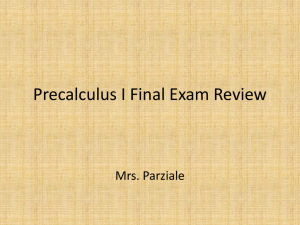Final Review, Math 1860 Thomas Calculus Early Transcendentals, 12 ed
advertisement

Final Review, Math 1860 Thomas Calculus Early Transcendentals, 12 ed 6. Applications of Integration: 5.6 (Review Section 5.6) Area between curves y = f (x) and y = g(x), a ≤ x ≤ b is Rb |f (x) − g(x)| dx and similarly for x = f (y) and x = g(y). a Rb 6.1 Volumes by slices: a A(x) dx where A(x) is the area of the cross section perpendicular to the x-axis. Special case is the solid of rotation obtained by rotating the region between curves y = f (x) and y = g(x), a ≤ x ≤ b about the x-axis: Z b π|f (x)2 − g(x)2 | dx. a What happens in the case the axis of rotation is y = 3? There is an analogous formula obtained by interchanging x and y. Example: The region between the curves x = y 2 and y = x − 2 is rotated about the y-axis. Find the volume of the solid generated. 6.2 The method of cylindrical shells: the region between curves y = f (x) and y = g(x), Rb a ≤ x ≤ b about the y-axis: a 2πx[f (x) − g(x)]dx. What happens when the axis of rotation is x = −2? Again interchanging x and y gives an analogous formula. Example: Rotate the region in the previous example around the x-axis. 6.3 Arc Length. The curve y = f (x), a ≤ x ≤ b has length Z bp 1 + (f ′ (x))2 dx a 6.4 Area of Surfaces of Rotation: The curve y = f (x), a ≤ x ≤ b is totated about the x axis. Find the area of the surface. Z b p 2π |f (x)| 1 + (f ′ (x))2 dx a 7. Transcendental Functions: Rx 7.1 The Natural Logarithm ln x = 1 (1/t) dt Rhas has the property ln(xy) = ln x + ln y etc. (d/dx) ln u = (1/u)du/dx. What is tan x dx? 7.1 ex , the Natural Exponential is the inverse of ln x: eln x = x = ln(ex ). (d/dx)eu = eu du/dx and we saw exp(x) = ex if x is rational and so for all √ 7.1 General logs and exponentials. Differentiate y = 3sec x . or y = log2 x. ex − e−x sinh x ex + e−x ; sinh x = and tanh x = . 2 2 cosh x 8. Techniques of Integration: 7.3 Hyperbolic Functions: cosh x = 2 8.1 Integration by parts: 1-24? R R u dv = uv − v du. On p 407, what is u and dv in questions 8.2 Integration of powers of Trig functions Identities: (a) (sin x)2 + (cos x)2 = 1 1 (b) (cos x)2 = (1 + cos 2x) 2 1 (c) (sin x)2 = (1 − cos 2x) 2 2 (d) (sec x) = (tan x)2 + 1 (e) (csc x)2 = (cot x)2 + 1 (f) sin 2x = 2 sin x cos x (g) cos 2x = (cos x)2 − (sin x)2 Z (sin x)m (cos x)n dx Cases: m is odd (u = cos x); n is odd (u = sin x); m and n even 1 1 (cos x)2 = (1 + cos 2x) (sin x)2 = (1 − cos 2x) 2 2 8.2 Integration of powers of Trig functions Z (tan x)m (sec x)n dx If n is even substitute u = tan x. If m is odd then substitute u = sec x. Also Z sec x dx = ln | sec x + tan x| + C Also Z sec x dx = ln | sec x + tan x| + C 8.3 Trig Substitution For Integrals Involving √ 2 2 √a − x a2 + x 2 Substitute x = a sin θ, dx = a cos θ dθ x = a tan θ, dx = a(sec θ)2 dθ Use the Identity √ 2 2 √a − x = a cos θ a2 + x2 = a sec θ 8.4 Partial Fractions. 1. Divide; 2. Factor divisor 3. Expand by partial fractions 4. Solve for coefficients 5. Integrate. 3 8 Evaluate Z x arctan x dx Z (cos x)(sin x)6 dx Z (cos x)4 dx Z (tan x)3 dx Z √ 1 − v2 dv v2 Z 1 + x2 dx (1 + x)3 = = = = = ∞ 1 dx < ∞ if and only if p > 1. xp 1 R∞ g(x) dx < ∞ implies 1. Comparison Test. Assume 0 ≤ f (x) ≤ g(x). Then a R∞ R∞ R∞ f (x) dx < ∞ OR f (x) dx = ∞ implies g(x) dx = ∞ a a a 8.7 Improper integrals. Type I and II. Z 10. Series: 10.1 Sequences ln n =0 n→∞ n (b) lim n1/n = 1 (a) lim n→∞ (c) lim x1/n = 1 n→∞ (d) lim xn = 0 if |x| < 1. n→∞ x n (e) lim 1 + = ex n→∞ n xn =0 (f) lim n→∞ n! 2. Series. 10.2 Geometric series a + ar + ar2 + ar3 + . . . = a/(1 − r). 10.2 Telescoping series. 10.2 nth term test for divergence. limn an 6= 0 10.3 Integral Test P p 10.3 p-series ∞ n 1/n converges iff p > 1. P 2 10.4 Comparison Test ∞ n 1/(n + n) 4 10.4 Limit Comparison Test. P∞ n 1/(n2 − n) 10.6 Conditional or absolute convergence? P √ n−1 10.5 Alternating Series Test. Is ∞ / n conditionally convergent? AST n (−1) is only for conditional convergence. 10.6 Ratio Test. limn |an+1 /an | 10.6 Root Test. limn |an |1/n P n 10.7 Power series ∞ n=0 cn (x − a) . Radius of convergence and interval of convergence. Ratio or root test. Check end points? P n 10.8 Integration and differentiation of power series: f (x) = ∞ n=0 cn (x − a) ′ f (x) = ∞ X n=1 Z ncn (x − a)n−1 ∞ X cn (x − a)n+1 f (x) dx = C + n+1 n=0 All three power series have the same radius of convergence. 10.8 The geometric series and power series. For example, 1/x = 1/(1 + (x − 1)) = 1 − (x − 1) + (x − 1)2 − (x − 1)3 + . . . (Here r = −(x − 1) and a = 1. Convergence if |r| = |x − 1| < 1. 10.9 Taylor series and Maclaurin series (a = 0) ∞ X f (n) (a) n=0 n! (x − a)n and Taylor polynomials, TN (x) of degree N is PN (x) = 10.9 Common Maclaurin series: PN n=0 f (n) (a) (x n! x2 xn + ... + ... 2! n! x2 x4 (−1)n x2n cos x = 1 − + + ... + + ... 2! 4! (2n)! (−1)n x2n+1 x3 x5 + + ... + + ... sin x = x − 3! 5! (2n + 1)! ex = 1 + x + 10.10 Integration of power series like that of ex Parametric and Polar Curves. 11.1 Parametric Curves. Graphing 2 − a)n 5 dy/dt dy = . Tangent line to a parametric curve. dx dx/dt Z bp (x′ (t))2 + (y ′ (t))2 dt Length (compare to Section 6.3) 11.2 Parametric Curves and Calculus. a 11.3 Polar Coordinates 11.4 Polar Coordinates. Graphing. Circles (r =constant. r = a cos θ r = a sin θ) and cardioids (r = a(1 ± cos θ) or r = a(1 ± sin θ)) and the flowers like r2 = sin 3θ. Z β 1 f (θ)2 dθ 11.5 Area in polar coordinates α 2 R3 12.1 Distance between points. 12.1 Equation of a sphere centered at (4,-1,3) and radius 8. 12.2 Vectors. Length and direction. Unit vectors. Force, displacement and velocity. 12.3 Dot product. Algebraic and geometric difinitions. Angle between vectors. 12.3 Component of ~b along ~a: comp~a~b = (~a · ~b)/|~a|. Projection of ~b along ~a: proj~a~b = ~a · ~b ~a. |~a|2 12.4 Cross product. Algebraic and geometric definitions. ~a × ~b is perpendicular to ~a and ~b and by the right hand rule. Length is the area of the parallelogram. 12.4 Triple vector product ~a · (~b × ~c). Take absolute value of this real number to get the volume of the parallelepiped determined by the 3 vectors. 12.4 ~a · ~b is a real number; ~a × ~b is a vector. 12.5 Equation of a plane through three points P Q and R. The normal is P~Q × P~R. 12.5 Parametric equation of the line through P (a, b, c) and Q is hx, y, zi = ha, b, ci+tP~Q. Here P~Q = hd1 , d2 , d3 i is the direction vector of the line and we have x = a + td1 , y = b + td2 and z = c + td3 if we write out the components. 12.5 The symmetric equations of the same line are x−a y−b z−c = = d1 d2 d3



